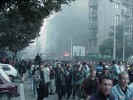Covering the disintegration of Yugoslavia has often forced
reporters to act as scouts without compasses in a completely unknown terrain.
Reporters have had to wade through the complex cultural, historical and political
geography of these conflicts. And very few had the necessary instruments. With the end of
the Cold War, a whole set of principles of analysis had become useless, and reporters had
to confront new problems that most of them had never explored before, such as ethnic
self-assertion, tribalism, religious conflicts and the rights and limits to
self-determination.
The wars in Slovenia, Croatia and Bosnia have not been played out only in the
battlefield. They have also been wars of faxes and computer messages. Starting with the
10-day war in Slovenia in June-July 1991, one of the most difficult tasks for reporters
has been to protect themselves from the propaganda offensive. The
Slovenes never missed an opportunity to depict the conflict in the bloodiest terms
possible in order to win international support for their cause as a "westward-leaning
democracy" against the "brutal Communist aggressor." Those labels stuck and
were reinforced as the war moved into Croatia.
The Croats soon learned from the Slovenes' use of propaganda. The
Croatian news agency HINA and Croatian radio and TV unremittingly bombarded the outside
world with minute details of the clashes, most of which were impossible to check. The best-known examples of vast exaggeration were reports of the massive
damage inflicted on Dubrovnik, the magnificent medieval fortress city on the
Adriatic. For months, Croatian media reported that the monuments in the old quarter had
been devastated by Yugoslav Army shells and mortars. Western
journalists who visited the walled city after the campaign ended reported seeing only
superficial damage.
Another striking example of manipulation of facts was the case of
a massacre in Gospic, Croatia, in 1991. Film footage showing the mutilated bodies
of two young men was aired on Croatian and German TV, which identified the victims as
Croats slaughtered by Serbs. The bodies were later recognized by
relatives as being those of Serbs. The German network later apologized for the false
report.
The Croats went even further than the Slovenes in the information war. Not only did the
Croatian government hire the public relations firm Rudder-Finn to get its message out, but
Croatia mobilized expatriate communities in the United States, Canada and Australia to put
pressure on the media in their home countries.
Letter-writing campaigns by members of both Croatian and Serbian communities in the
U.S. criticizing news coverage have been a constant of the Yugoslav wars. The aim appeared to be to discredit the correspondent in the field, and
many reporters told me they were having more and more difficulty in convincing their
editors that what they had seen first hand was the real story, not what was contained in
the U.S.-originated faxes.
These have not been wars where the warring factions organize trips and escort
journalists to the front-line, or where journalists can depend on independent pool
reports. Press conferences by military leaders, other than by U.N. officials, have been
rare. Journalists in the war zones have been on their own. The risks have been enormous
(more than 30 journalists have been killed since the conflicts began), all the more so in
a political culture where militiamen of all the warring sides are convinced journalists
are spying for the enemy.
A Croatian militiaman guarding a prison camp in Southern Bosnia summed up this attitude
when he menacingly told an Associated Press reporter who was trying to get into the
camp last year, "Reporters are like soldiers--the less they know, the longer they
live."
The Serbs' deep-rooted conviction that throughout history they have been the victims of
foreign powers has put them at a disadvantage in the propaganda war. Little
or no effort has been made by the Belgrade government to try to win over the hearts and
minds of the West through its media. This has fomented a profound distrust,
bordering on outright hatred, for foreign reporters, who are widely blamed by Serbs for
their international isolation.
I went to Sarajevo for the first time in September 1991, six months before the war
started, and I was struck by the sophistication and cosmopolitanism of the city. The
Writers' Club, an elegant, glass-enclosed restaurant and jazz bar, was filled with
intellectuals, film makers and journalists. The skyline of old Sarajevo was famous for the
proximity of its Orthodox and Catholic churches, mosques and synagogues. (The only
unwritten rule was that no minaret or bell tower could be higher than any of the other
houses of worship.)
Dealing with Sarajevo's citizens was immediately easy. Nearly everyone I met spoke a
foreign language and had traveled widely in Europe. Many were Muslims, because for
centuries Muslims lived primarily in the cities, and as representatives of the urban
middle class, they naturally became foreign journalists' favorite sources.
Months later, traveling through Bosnian villages just before the outbreak of the
conflict, I discovered a reality that was perhaps unknown even to many citizens of
Sarajevo. The much-touted religious tolerance and intermingling of Serbs, Croats and
Muslims symbolic of the Bosnian capital was often rare outside urban areas.
The impression created by secular, multicultural Sarajevo may have helped overshadow
some of the main aspects of the war. The conflict has been variously described as a civil
war based on ethnic and religious hatred, as an inevitable explosion after decades of
Communist suppression of nationalist differences, or as a simple land grab.
But traveling through the countryside another aspect emerged. It is what the former
mayor of Belgrade--and Milosevic opponent--Bogdan Bogdanovic describes as a war of the
mountain against the city, of rural backwardness against urban co-existence. The
cornerstone of the Muslim-led government's appeal for a united Bosnia--and the message it
has promoted through the media to the outside world--has been shaped by the cosmopolitan
reality of Sarajevo and some other cities, but does not always correspond to the pre-war
tensions and animosities that had long existed in many other parts of Bosnia.
If one went to look at the results of the first free elections in Bosnia in the fall of
1990, it was clear that the harmony of Sarajevo was unique: Throughout Bosnia, the ethnic
parties prevailed, and voting results mirrored the map of ethnic population distribution.
But, as the major information sources, Muslim intellectuals and their leaders (often
providing inflated statistics on mixed marriages) were very successful in exploiting an
image of pre-war idyllic co-existence, and the media in turn reduced
an extremely complex situation to a war of aggression from the outside.
It was not until August 1992, when the first refugees from northern Bosnia arrived in
Croatia, that the world learned of concentration camps and of vicious campaigns of
"ethnic cleansing." The refugees told stories of harassment, fighting,
atrocities and expulsions by Serbs that had begun many months before. And it was not until
the Muslims and Croats--erstwhile allies--began massacring each other in the spring of
1993 that journalists were forced to deal with the "other war" and discovered
that reciprocal "ethnic cleansing" had been going on for months in central and
southwestern Bosnia.
In June 1993, two American reporters who had been covering the region for some time
were discussing the disastrous role the international community had played in this
tragedy. "But it has been journalism's finest hour," one of the reporters then
said.
I beg to differ. There have been innumerable instances where
those of us who have covered these conflicts have fallen into the disinformation trap.
One of the most insidious was the numbers game--number of dead,
number of refugees, and especially number of rape victims.
At the end of 1992, the Muslim-led Bosnian government said that
up to 50,000 Muslim women had been raped by Serbs in Bosnia. A
report by a special European Community commission, which did not include direct interviews
with victims, placed the number at 2,000.
On January 21, 1993, Amnesty International issued a report based on interviews with
victims conducted over months by the organization itself, by women's and human rights
groups working in the region and by journalists in the field. It
said all three warring sides in Bosnia had committed rapes and abuses against women.
The report added that the issue of rape has been widely used as a propaganda weapon, with
all sides minimizing or denying abuses committed by their own forces and maximizing those
of their opponents.
In Geneva, Amnesty International's legal officer, Nick Howen,
said in a news conference there was no evidence to back up the figure of 2,000 Muslim rape
victims cited by the European Community report. And in Zagreb, American relief workers I
spoke to dismissed that same estimate as highly exaggerated. But
still today, the number of 50,000 (and higher) has stuck and the prevailing perception is
that only Muslim women have been the victims and Serbian fighters the only perpetrators.
What has been almost completely ignored is that the numbers game has a long tradition
in the Balkans. Even today, there are no reliable figures indicating exactly how many
people died in the civil war during World War II or how many Serbs
were killed at the Ustasha concentration camp of Jasenovac in Croatia. (Serbs claim
as many as a million, Croats say as few as 100,000.) Nationalist leaders have
traditionally manipulated numbers like these as a means to foment ethnic tensions and
hatred as well as to cleanse the historical record.
As the conflicts have worsened and international organizations have become more and
more divided and impotent, I have felt that as journalists covering former Yugoslavia (at
times the only outsiders to be present in a particular area), we have found ourselves
bearing an enormous responsibility. Policy in Western capitals--or lack of it--has
increasingly been based on news reports, and many times the media
have been better at pulling emotional strings than at analyzing facts.
The use of good-guy and bad-guy stereotypes often obscured the complex origins of the
conflict. In his book The Rebirth of History, Misha Glenny had predicted that
the collapse of Communism and the end of the Cold War would render obsolete an Old World
Order system of analysis. He said it would profoundly change the
profession of journalism, which now requires a rediscovery of history, geography and a
rethinking of global relationships. Yugoslavia was the first serious test of this need of
a new approach.
No, I don't think it was journalism's finest hour. But it has
taught us the clear lesson that journalists as scouts now need new compasses if they are
to be a reliable link between facts on the ground and public opinion.
Sylvia Poggioli is a National Public Radio foreign
correspondent, based in Prague. In 1993, she received the George
Foster Peabody Award for coverage of the war in Bosnia.


